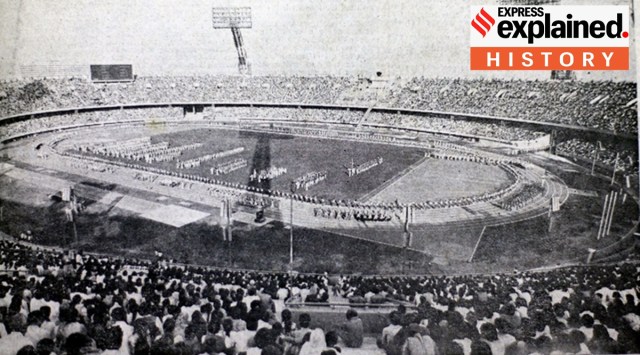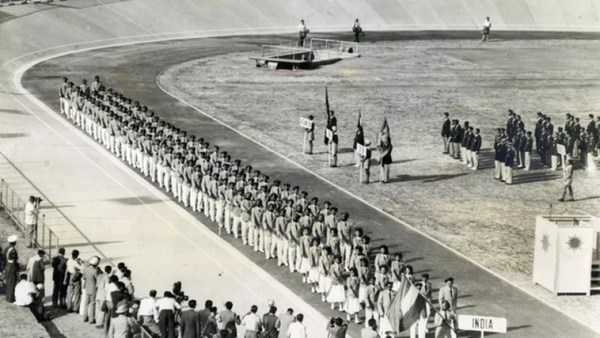The Asian Games, held every four years, had its very first edition hosted by India in 1951. It was first scheduled to be held in 1950 but was postponed by a year due to delays in preparation. The Games were officially opened by the then President Dr Rajendra Prasad at the Dhyan Chand National Stadium, known as National Stadium at the time.

 In picture, the Indian contingent marching into the stadium for the opening ceremony of the the first Asian Games. (Source: Wikimedia Commons)
In picture, the Indian contingent marching into the stadium for the opening ceremony of the the first Asian Games. (Source: Wikimedia Commons)
The National Stadium was built in 1933 as the Irwin Amphitheatre, a multipurpose stadium. It was renovated for the 1951 Games, and all the events except swimming were held on its premises. It was an achievement for India to host the event just a few years after its independence from British colonial rule in 1947. It also ranked second in the medals tally.
Asian Games, 1982
India hosted the Asian Games for the second time in 1982, the ninth edition overall, after a gap of 31 years. The Games were officially opened by former Indian president Zail Singh at the Jawaharlal Nehru Stadium. P T Usha, one of India’s greatest athletes, read the athletes’ oath.
 In picture, the then Prime Minister Indira Gandhi holds up the Games torch at the JLN Stadium. (Express Archive)
In picture, the then Prime Minister Indira Gandhi holds up the Games torch at the JLN Stadium. (Express Archive)
The 1982 Asian Games not only gave a number of medals to India but also transformed Delhi, which joined Bangkok as the only city to host multiple editions of the Asian Games. The Asian Games Village (also known as Khelgaon) was constructed in south Delhi’s Siri Fort to house the athletes. The Delhi Development Authority (DDA) in its advertisement called it “an architectural beauty that can be compared favourably with the games villages in the last three Olympics at Munich, Montreal and Moscow”.
While Delhi got a new look with a number of new roads and flyovers, the biggest contributions to the capital were the Indira Gandhi Indoor Stadium (then known as the Indraprastha Stadium), and the 60,000-seater Jawaharlal Nehru Stadium.
According to an earlier account in The Indian Express, following the government’s decision to upgrade facilities in 1980, two big stadiums (Jawaharlal Nehru Stadium and Talkatora Stadium), seven flyovers and a Games village with 4,200 rooms were completed in just two years. The DDA and the Central Public Works Department (CPWD) built all the major venues and received appreciation, as well as criticism.
Story continues below this ad
Many new hotels were also built for the guests. Among them, the India Tourism Development Corporation (ITDC) built seven new hotels, with the Samrat Hotel being one of the biggest. Other hotels that the ITDC built included Kanishka, Ashok Yatri Niwas, Akbar Hotel, Lodhi Hotel, Hotel Ranjit and the Qutab Hotel.
 The gold-medal-winning India’s women’s hockey team waves to spectators.
The gold-medal-winning India’s women’s hockey team waves to spectators.
(Express Archive)
This was the first Asian Games to introduce a mascot, with Appu – a baby elephant from Arunachal Pradesh. Indian officials said he represented the values of fidelity, wisdom and strength. However, media outlets later reported that he had to go through a brutal training regime. The less-than-satisfactory conditions in which 34 elephants were brought from Trichur, Kerala, were also criticised.
 The cycling velodrome where the cycling events were held in the Asian Games. (Express Archive)
The cycling velodrome where the cycling events were held in the Asian Games. (Express Archive)
Non-Aligned Movement (NAM) Summit, 1983
A year later, in 1983, India became host to another major event: the seventh Non-Aligned Movement (NAM) Summit. NAM was founded by the leaders of five countries: Sukarno of Indonesia, Jawaharlal Nehru of India, Josip Broz Tito of Yugoslavia, Gamal Abdul Nasser of Egypt and Kwame Nkrumah of Ghana. The organisation eventually saw many other countries from Asia and Africa join it during the Cold War era, in a bid to make their voice heard and not join the two power camps led by the United States and the USSR.
The NAM Summit opened in New Delhi with a call by the then Prime Minister Indira Gandhi, for a conference of the heads of state and government of all UN members to take a fresh collective look at some of the major problems facing the world.
Story continues below this ad
 New Delhi hosted the NAM Summit in 1983. (Express Archive)
New Delhi hosted the NAM Summit in 1983. (Express Archive)
Addressing the biggest-ever conference of heads of state and government at the Vigyan Bhawan, the PM made an impassioned appeal to Iran and Iraq to end their “tragic” war.
 India is one of the founding members of NAM. (Photo: X/@Jairam_Ramesh)
India is one of the founding members of NAM. (Photo: X/@Jairam_Ramesh)
Gandhi took over as chairman of the seventh Non-Aligned Summit from Cuba’s President Fidel Castro.
 (Express Archive)
(Express Archive)
Commonwealth Games, 2010
India became host to another international sporting event in 2010 after the two Asian Games in 1951 and 1982. On October 3, 2010, the 19th Commonwealth Games got off to a colourful start at the Jawaharlal Nehru Stadium in Delhi.
 The 19th Commonwealth Games were held in New Delhi. (Express Archive)
The 19th Commonwealth Games were held in New Delhi. (Express Archive)
The national capital saw a flurry of construction and beautification work ahead of the Games. One of Delhi’s premier sporting arenas, the Thyagraj Sports Complex, was built for the event. Four other venues were newly constructed for the Commonwealth Games: the Siri Fort Sports Complex, the Yamuna Sports Complex, Dr Karni Singh Shooting Range, and a rugby facility in the Delhi University Stadium. Apart from these, the Indira Gandhi Indoor Stadium and the JLN Stadium were renovated with upgraded modern facilities.
Story continues below this ad
Connaught Place, the bustling marketplace located in the centre of the city, was also re-developed and several subways were constructed in the run-up to the Games. The costs and value of such projects, however, also came under the Comptroller and Auditor General (CAG)’s scrutiny later on.
A Commonwealth Games Village was also constructed along the east bank of the Yamuna river, to provide accommodation and training to the participating athletes. The Commonwealth Games happen every four years and are contested by athletes from the Commonwealth of Nations, which is an international association of 56 member states, most of which were formerly colonised by the British Empire.
 A view of the Jawaharlal Nehru Stadium in New Delhi during the Commonwealth Games. (Express Archive)
A view of the Jawaharlal Nehru Stadium in New Delhi during the Commonwealth Games. (Express Archive)
G20 Summit, 2023
More than a decade after the Commonwealth Games, India will be hosting the G20 Heads of State and Government Summit on September 9 and 10 this year. Heads of state/government from all the G20 members (except for Russia’s Vladimir Putin and China’s Xi Jinping), the invited heads of state from other partner nations, and representatives of global organisations like the UN, IMF, World Bank and WTO, will arrive in Delhi to attend the meeting.
 Fountains installed at Dhaula Kuan, ahead of G20 Summit in New Delhi on Tuesday, August 29, 2023. (Express photo by Abhinav Saha)
Fountains installed at Dhaula Kuan, ahead of G20 Summit in New Delhi on Tuesday, August 29, 2023. (Express photo by Abhinav Saha)
For security, the department has installed 44 more CCTV cameras in addition to 1.20 lakh existing ones across Delhi. Further, quick response teams, wearing a special uniform, will be stationed at key roads which will work in coordination with Delhi Police and security personnel.
Story continues below this ad
 Artificial waterfall constructed near Airport, ahead of G20 Summit in New Delhi on Tuesday, August 29, 2023. (Express photo by Abhinav Saha)
Artificial waterfall constructed near Airport, ahead of G20 Summit in New Delhi on Tuesday, August 29, 2023. (Express photo by Abhinav Saha)
After months of work that involved coordination between various civic agencies, the Capital’s G20 transformation is complete. As the Summit draws closer, officials make last-minute inspections to ensure things are in order. Talking about what’s next on the agenda, a PWD official said: “We have met our target date — August 31. We will conduct a dry run from September 1-7. All roads, tunnels, underpasses and footpaths will be washed and water in fountains will be changed. From September 8-10, officers with valid permission will be stationed at various locations to ensure everything is in place. The PWD control room will personally monitor the functioning of fountains, lights, and civic infrastructure round the clock.”



 In picture, the Indian contingent marching into the stadium for the opening ceremony of the the first Asian Games. (Source: Wikimedia Commons)
In picture, the Indian contingent marching into the stadium for the opening ceremony of the the first Asian Games. (Source: Wikimedia Commons) In picture, the then Prime Minister Indira Gandhi holds up the Games torch at the JLN Stadium. (Express Archive)
In picture, the then Prime Minister Indira Gandhi holds up the Games torch at the JLN Stadium. (Express Archive) The gold-medal-winning India’s women’s hockey team waves to spectators.
The gold-medal-winning India’s women’s hockey team waves to spectators. The cycling velodrome where the cycling events were held in the Asian Games. (Express Archive)
The cycling velodrome where the cycling events were held in the Asian Games. (Express Archive) New Delhi hosted the NAM Summit in 1983. (Express Archive)
New Delhi hosted the NAM Summit in 1983. (Express Archive) India is one of the founding members of NAM. (Photo: X/@Jairam_Ramesh)
India is one of the founding members of NAM. (Photo: X/@Jairam_Ramesh) (Express Archive)
(Express Archive) The 19th Commonwealth Games were held in New Delhi. (Express Archive)
The 19th Commonwealth Games were held in New Delhi. (Express Archive) A view of the Jawaharlal Nehru Stadium in New Delhi during the Commonwealth Games. (Express Archive)
A view of the Jawaharlal Nehru Stadium in New Delhi during the Commonwealth Games. (Express Archive) Fountains installed at Dhaula Kuan, ahead of G20 Summit in New Delhi on Tuesday, August 29, 2023. (Express photo by Abhinav Saha)
Fountains installed at Dhaula Kuan, ahead of G20 Summit in New Delhi on Tuesday, August 29, 2023. (Express photo by Abhinav Saha) Artificial waterfall constructed near Airport, ahead of G20 Summit in New Delhi on Tuesday, August 29, 2023. (Express photo by Abhinav Saha)
Artificial waterfall constructed near Airport, ahead of G20 Summit in New Delhi on Tuesday, August 29, 2023. (Express photo by Abhinav Saha)




































